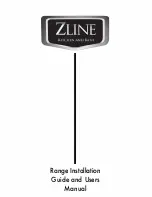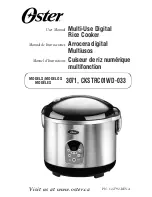
10
Lower oven
Similarly to the upper oven, the
LOWER
oven is indirectly
heated by two elements, one concealed in the base and the
other visible in the top of the oven. These elements heat the
twin-lined cavity oven to provide cooking results comparable
with traditional heat storage ovens, but with flexibility to
turn the oven off when not in use. The appliance features two
settings
BAKE
and
SIMMER
.
The
BAKE
(
) setting is a moderate baking oven, ideal
for cakes, biscuits and anything requiring moderate heat such
as fish pie, lasagne, soufflés, crumbles and roulades. Meat
and poultry can be cooked in this oven over longer periods
of time. For the best results when baking cakes; place them in
the middle of the oven, swap trays using more than one shelf
and allow air circulation around baking trays and tins.
The
SIMMER
) setting converts the lower oven to a
cooler temperature simmering oven, sometimes referred to
as a continuation oven, as it continues to cook foods brought
up to heat on the hotplate or Upper oven on Roast setting. It
is ideal for soups, casseroles, steamed puddings, vegetables,
rice pudding, savoury rice and anything requiring long slow
cooking. It can also be used to dry out meringues. Take care
not to overload the oven as air needs to circulate to continue
the cooking process. See table for further guidance.
The
WARMING
(
) oven is indirectly heated by one
element in the base of the oven.
The
OVEN IS NOT A HOLDING OVEN
and therefore is not
designed to hold food at a given temperature for long
periods.
The warming oven is designed to warm plates and serving
dishes and keep prepared food warm for a short period until
it is convenient to serve.
Operate the warming oven via the separate push switch in
the centre of the control panel, a red neon indicates that the
warming oven is on
The Rayburn Ranger® has an
‘e’
setting which will reduce
running costs and the useful heat into the room will be
reduced.
The heating up time to full temperature from the ‘e’ setting is
approximately 1 hour.
The ‘
e
’ setting will reduce the
UPPER
oven to a low bake
temperature; the
LOWER
oven will reduce to a simmer
temperature.
The upper oven is ideal for baking, especially when baking is
required over longer periods for example fruit cakes
PLEASE NOTE
: If you wish to bake in the upper oven when it
has been at full temperature, you have to select the ‘e’ setting.
Because of the heat retention the oven will hold its heat for a
considerable amount of time, therefore allow approximately
2 hours for the temperature to cool down.
e
Fig. 6.6
Fig. 6.7
Fig. 6.8
Fig. 6.9















































